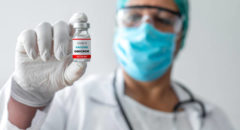
Los Angeles County’s rise in coronavirus cases over the last two weeks has posed a challenge in that 99% of the people getting sick are unvaccinated. Those who have gotten their shots are protected and can get back to normal life after more than a year of pandemic shutdowns. Officials have been desperately trying to convince those who have not gotten their shots to do so, but results are limited. As a result the county is now requiring everyone — vaccinated and unvaccinated — to wear masks inside public places.
The vaccines are believed to be essentially as effective against the Delta variant as it is against the other existing variants. This has meant that those who got their shots need not wear a mask to protect themselves. But officials suspect that unvaccinated people have also stopped wearing masks in indoor public settings and businesses, despite being required to do so.
This has led the government to ask vaccinated people to make a sacrifice to help slow coronavirus spread among the unvaccinated by wearing a mask.
Times data show that 51.8% of all Californians are fully vaccinated to date, though wide regional gaps persist. In San Diego County it’s 57%, in Orange County 54.7%, and in L.A. County 52.2%. The rates are much lower in Riverside County (42.1%) and San Bernardino County (39.2%)
Community transmission has increased dramatically in L.A. County since California fully reopened on June 15. At that time, the county was averaging 173 new coronavirus cases a day. For the seven-day period that ended Wednesday, the county’s average was 1,077 new cases a day. On Thursday, the county reported 1,537 additional cases.
Countywide, COVID-19 hospitalizations increased over that same period — from 223 on June 15 to 452 as of Wednesday. Still, cases and hospitalizations are more than 93% below what they were at the peak of the winter surge. And deaths remain at historically low levels, averaging about seven a day.
Although officials don’t expect hospitals to ever be as stressed with COVID-19 patients as they were during the winter surge, the healthcare system could still be significantly affected if trends continue.
“There is still time to take action and protect people through vaccination, since we are starting from a lower baseline rate,” Dr. Roger Lewis, who directed COVID-19 hospital demand modeling for the L.A. County Department of Health Services, wrote in an email. “It is critically important that everyone eligible for vaccination who has not already been vaccinated does so as quickly as possible.”
The newmask health order goes into effect at 11:59 p.m. Saturday.
Long Beach, which has its own public health department, will align with L.A. County’s order. Pasadena, which also has its own health department, already recommends that everyone — including the fully vaccinated — wear masks in indoor public settings, and the city is “reviewing options for a mandate,” according to a spokeswoman.
Public indoor spaces such as theaters, stores, public venues and shopping malls will essentially revert back to mask wearing like they were before the county lifted them before the June 15 reopening. The order will continue to allow indoor restaurant dining, but it requires people to keep their masks on while they order and while waiting for food. The order does not require a reduction in business capacity or a return to mandatory physical distancing.
The University of California announced Thursday that COVID-19 vaccinations will be required before the fall term begins for all students, faculty and others, becoming the nation’s largest public university system to mandate the vaccines even though they don’t have full federal approval.
San Francisco has been a leader in imposing vaccination requirements for some. The city has ordered all workers in “high-risk settings” — such as hospitals, nursing homes and residential facilities for older people, homeless shelters and jails — to be fully vaccinated by Sept. 15. An exemption will be available for workers with valid religious and medical reasons, and they will be required to get tested for the coronavirus weekly.
Some public health experts have said effective approaches for persuading people to get vaccinated include answering questions and making the vaccine even more available to those who may not have prioritized getting the shot, either because they don’t think COVID-19 is a threat to them or because of swirling misinformation surrounding the shots.
“Relationships really matter,” said Dr. Christina Ghaly, L.A. County’s director of health services. Giving people “an opportunity to ask their questions, to get fact-based information about the vaccine, to be given a chance to just talk through their concerns” is an effective approach, she added.
“One-on-one conversations — it’s very labor intensive, not always very fast, it takes time,” she said. “But that’s been the best thing that has really helped.”








